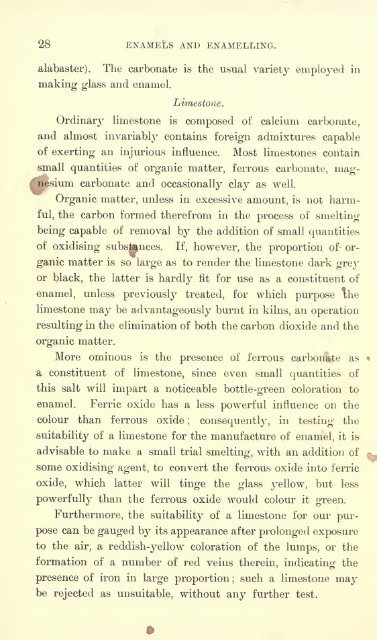Enamels and enamelling; an introduction to the preparation and ...
Enamels and enamelling; an introduction to the preparation and ...
Enamels and enamelling; an introduction to the preparation and ...
Create successful ePaper yourself
Turn your PDF publications into a flip-book with our unique Google optimized e-Paper software.
28 ENAMELS AND ENAMELLING.<br />
alabaster). The carbonate is <strong>the</strong> usual variety employed in<br />
making glass <strong><strong>an</strong>d</strong> enamel.<br />
Limes<strong>to</strong>ne.<br />
Ordinary limes<strong>to</strong>ne is composed of calcium carbonate,<br />
<strong><strong>an</strong>d</strong> almost invariably contains foreign admixtures capable<br />
of exerting <strong>an</strong> injurious influence. Most limes<strong>to</strong>nes contain<br />
small qu<strong>an</strong>tities of org<strong>an</strong>ic matter, ferrous carbonate, mag-<br />
nesium carbonate <strong><strong>an</strong>d</strong> occasionally clay as well.<br />
Org<strong>an</strong>ic matter, unless in excessive amount,<br />
is not harm-<br />
ful, <strong>the</strong> carbon formed <strong>the</strong>refrom in <strong>the</strong> process of smelting<br />
being capable of removal by <strong>the</strong> addition of small qu<strong>an</strong>tities<br />
of oxidising subs^nces.<br />
If, however, <strong>the</strong> proportion of org<strong>an</strong>ic<br />
matter is so large as <strong>to</strong> render <strong>the</strong> limes<strong>to</strong>ne dark grey<br />
or black, <strong>the</strong> latter is hardly fit for use as a constituent of<br />
enamel, unless previously treated, for which purpose <strong>the</strong><br />
limes<strong>to</strong>ne may be adv<strong>an</strong>tageously burnt in kilns, <strong>an</strong> operation<br />
resulting in <strong>the</strong> elimination of both <strong>the</strong> carbon dioxide <strong><strong>an</strong>d</strong> <strong>the</strong><br />
org<strong>an</strong>ic matter.<br />
More ominous is <strong>the</strong> presence of ferrous carbonate as<br />
a constituent of limes<strong>to</strong>ne, since even small qu<strong>an</strong>tities of<br />
this salt will impart a noticeable bottle-green coloration <strong>to</strong><br />
enamel. Ferric oxide has a less powerful influence on <strong>the</strong><br />
colour th<strong>an</strong> ferrous oxide ; consequently, in testing <strong>the</strong><br />
suitability of a limes<strong>to</strong>ne for <strong>the</strong> m<strong>an</strong>ufacture of enamel, it is<br />
advisable <strong>to</strong> make a small trial smelting, with <strong>an</strong> addition of<br />
some oxidising agent, <strong>to</strong> convert <strong>the</strong> ferrous oxide in<strong>to</strong> ferric<br />
oxide, which latter will tinge <strong>the</strong> glass yellow, but less<br />
powerfully th<strong>an</strong> <strong>the</strong> ferrous oxide would colour it green.<br />
Fur<strong>the</strong>rmore, <strong>the</strong> suitability of a limes<strong>to</strong>ne for our pur-<br />
pose c<strong>an</strong> be gauged by its appear<strong>an</strong>ce after prolonged exposure<br />
<strong>to</strong> <strong>the</strong> air, a reddish-yellow coloration of <strong>the</strong> lumps, or <strong>the</strong><br />
formation of a number of red veins <strong>the</strong>rein, indicating <strong>the</strong><br />
o<br />
presence of iron in large proportion; such a limes<strong>to</strong>ne may<br />
be rejected as unsuitable, without <strong>an</strong>y fur<strong>the</strong>r test.
















